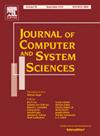Algorithms and Turing kernels for detecting and counting small patterns in unit disk graphs
IF 0.9
3区 计算机科学
Q1 BUSINESS, FINANCE
引用次数: 0
Abstract
In this paper we investigate the parameterized complexity of counting and detecting small patterns in unit disk graphs: Given an n-vertex unit disk graph G with an embedding of ply p (i.e. G is an intersection graph of closed unit disks, and each point is contained in at most p disks) and a k-vertex unit disk graph P, count the number of (induced) copies of P in G. For general patterns P, we give an time algorithm for counting pattern occurrences. We show this is tight, even for ply : any time algorithm violates the Exponential Time Hypothesis (ETH). Our approach combines tools developed for planar subgraph isomorphism such as ‘efficient inclusion-exclusion’ from Nederlof (2020) [15], and ‘isomorphisms checks’ from Bodlaender et al. (2016) [5] with a different separator hierarchy and a new bound on the number of non-isomorphic separations tailored for unit disk graphs.
检测和计算单位盘图中的小模式的算法和图灵内核
在本文中,我们研究了计算和检测单位盘图中小图案的参数化复杂性:给定一个具有 ply p 嵌入的 n 个顶点单位盘图 G(即 G 是封闭单位盘的交集图,且每个点最多包含在 p 个盘中)和一个 k 个顶点单位盘图 P,计算 P 在 G 中的(诱导)副本数。对于一般图案 P,我们给出了一个 2O(pk/logk)nO(1)时间的算法来计算图案出现次数。我们证明了这一算法的严密性,即使对于 ply p=2 也是如此:任何 2o(n/logn)nO(1)时间算法都违反了指数时间假说 (ETH)。我们的方法结合了为平面子图同构开发的工具,如 Nederlof (2020) [15] 的 "高效包容-排除 "和 Bodlaender 等人 (2016) [5] 的 "同构检查",以及不同的分离器层次结构和为单位盘图量身定制的非同构分离数量新约束。
本文章由计算机程序翻译,如有差异,请以英文原文为准。
求助全文
约1分钟内获得全文
求助全文
来源期刊

Journal of Computer and System Sciences
工程技术-计算机:理论方法
CiteScore
3.70
自引率
0.00%
发文量
58
审稿时长
68 days
期刊介绍:
The Journal of Computer and System Sciences publishes original research papers in computer science and related subjects in system science, with attention to the relevant mathematical theory. Applications-oriented papers may also be accepted and they are expected to contain deep analytic evaluation of the proposed solutions.
Research areas include traditional subjects such as:
• Theory of algorithms and computability
• Formal languages
• Automata theory
Contemporary subjects such as:
• Complexity theory
• Algorithmic Complexity
• Parallel & distributed computing
• Computer networks
• Neural networks
• Computational learning theory
• Database theory & practice
• Computer modeling of complex systems
• Security and Privacy.
 求助内容:
求助内容: 应助结果提醒方式:
应助结果提醒方式:


